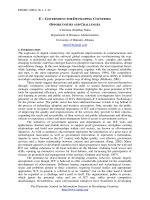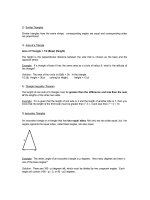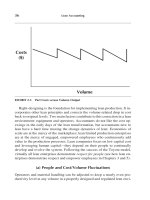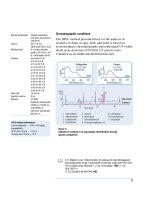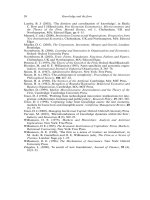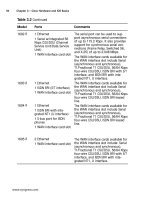Renewable energy technologies for developing countries phần 3 ppt
Bạn đang xem bản rút gọn của tài liệu. Xem và tải ngay bản đầy đủ của tài liệu tại đây (62.64 KB, 10 trang )
- 17 -
the overall risk tends to fall even though community risk rises because of
the shift of household to community impacts.
3. Rural Energy
a) The Basic Problem
The fundamental issue involved in the efficient use of non-conventional
energy sources is to bring about the integration of socio-economic changes
with technological innovations, which essentially should be made simple,
easy to understand and operate (maintain) by the agrarian population.
Most of this agrarian population is either illiterate or semi-literate in the
developing countries. In view of this basic issue, the problem here is mainly
the identification of available technologies, their testing to make them
suitable in the local situations and for their acceptability in relation to their
costs as well as, the financial or technological capacity of the rural people
to operate, maintain and repair the hardware involved.
The technological problems of adaptation and innovation, to match
the available technologies and hardware with the local circumstances, may
prove to be serious constraints to many developing countries in implementing
their programmes. However, these problems will need to be divided into
manageable proportions, in terms of (i) what is available for immediate
application, and (ii) what needs further Research and Development.
Technologies are available, even in many developing countries, for simpler
application of both direct and indirect solar energy. In regard to the first
Figure - 10(b): Urban particulate
concentrations, human exposure, and
national development
- 18 -
category, the critical technological problems are providing the appropriate
software for use in primary consumption of the energy made available
from alternative non-conventional sources.
The rural energy problems revolve mainly around lack of proper level
of education and knowledge amongst the farmers, leading to the continued
adoption of old customs and traditions handed down from generations. In
order to break the shackles of these old traditions, radical measures have
to be adopted, particularly in the matter of improving the level of their
scientific and technological education, through visual aids and other
effective techniques, and the introduction of new concepts in close
collaboration with them.
Present Status of some Renewable Energy Applications in Third
World Countries
Majority of world’s population about (80%) live in the developing
countries but use only 30% of global commercial energy. The energy usage
increase with increase in population living standards and development.
Realization is growing to make use technologies which it can lead to rural
development, as well as keep the air pollution low. Experienced gained in
RET application is presented tabular form, refer to table 5.2 or 2.2. This
indicates that five areas of application at rural include residential and
community lighting, small industry, agriculture, gas based power generation,
cooking & water heating and transportation (alternate fuels). Biomass
(traditional fuel) accounts for 30-50% of primary energy-supply in many
developing countries.
Rural Resident/Community Lighting/Telephony, Radio and TV
Developing countries have 40% population (about 400 Million) of the
developing countries reside in rural area with no electricity. An estimate
of 1.1 Million Solar Home System and Solar lanterns exist in rural areas
of developing countries.
Solar Home Systems
The figures in some developing countries are as follows :
- 19 -
India : 450,000, China : 150,000, Kenya : 120,000, Morocco :
80,000, Mexico : 80,000, South Africa : 50,000.
Bio-Gas digester convert animal waste into fuel gas for lighting,
heating, cooking & electricity generation in China, India and Nepal has
now largest manufacturing industries for biogas plants. China leads with
7.5 Million household biogas plants, 750 large & Medium scale industrial
Biogas plants and a network of rural “biogas service centres” to provide
maintenance & support. Micro-hydro power are installed in China, India,
Nepal and Pakistan (500). Micro Windpower (100-5000 W) has also been
installed in China (150,000) India, Pakistan and Nepal.
RETs for Industry, Agriculture
Major application of RETs is in the field of agriculture, such as for
pumping water for drinking, education and health care centres. Such
pumps are installed in India (20,000) Ethopia, Thailand, Mali,
Philippines, Morocco and Pakistan.
Grid-based Power Generation
- Small Hydro Power : Nepal, Pakistan, India, China, Egypt and African
countries
- Biomas Power : China, India, Indonesia, Malaysia etc.
- Wind Power : China, India, Syria, Jordan and some African countries
Hotwater & Cooking (Biomass Stove)
China, India, Egypt, Cypres, Pakistan, Bangladesh, Nepal, Iran,
Syria, Jordan, Turkey etc and African countries.
Transport Fuel (Bio Fuel)
Ethanol, Brazil, Kenya, Maldeve and Zimbabwe
PV home system / Lantern / Mini-grid and Biogas
Provided better basic amenity of life including :
- 20 -
3.(b) “Dennis Anderson (U.K)”, Energy and Economic Prosperity, “World Energy
Assessment : Energy and the challenges of Sustainability” 2000 UNDP Report, p. 396.
- Clean water for drinking
- Hygenic condition
- Lighting System
- Better Living condition
- Supported Small Industry / Entrepreneurs
- Education
- Tele-communication
- Better living condition for women
- Income-eneration / Economic
- Better standard of living
Rural Enterpreneur Development and Business Opportunity are also
developed for sustainability.
(b) Some Useful RETs for Rural applications
The essential distinction between the generation of energy from
non-conventional sources and its actual application must be constantly
kept in view, so that an excessive pre-occupation with the problems of
developing energy supplies from alternative sources will not overshadow
the equally important technological problem of creating the necessary
conditions for mass application of alternative energy supplies.
Wood and dung constitute the main sources of rural energy in
developing countries. (See Fig. 11 for biomass as a cooking fuel)
3(b)
The
possibilities of finding immediate substitutes for these are limited. The
replacement of such non-commercial fuels, at present, often implies a
transition to petroleum products, which are themselves becoming increasingly
costly in foreign exchange and therefore, less available. On the other hand,
large-scale dependence on wood has resulted in depletion of forests, soil
run-off and erosion, desertification and a steady decline in crop-yields. The
plantation of quick-growing trees and energy forests is, therefore, a matter
that deserves serious consideration for implementation on a massive scale.
- 21 -
The cumulative impact of the effective use of even small amounts of
energy in rural areas can be considerable. Agricultural productivity, rural
industries, health, communications and educational opportunities could all
benefit from the availability of even lower-power devices, thus leading,
perhaps, to a slowing of the rural exodus and improving the prospects for
balanced economic development. Estimates of the amount of energy
required to provide subsistence vary with specific circumstances. Thus,
per-capita levels of energy consumption range from 11,000 kilograms
coal equivalent (kgce) per annum in North America to between 5 and 10
percent of that figure in developing countries, even when non-commercial
energy is included. Several studies concur that a per-capita consumption of
about 400-500 kgce/annum would coincide with the minimum provision
of food and shelter in a rural agricultural setting.
The combined pre-capita commercial and non-commercial energy
consumption, which ranges from 480 kgce/annum for agricultural non-
exporters to 1,600 kgce/annum for industrialized developing countries,
leaves some 75 percent of the world population at or below the energy
consumption level necessary to meet basic human needs. A target of 2,000
kgce/a i.e. 2 T.C.E. per annum, which was the world average in 1979 and
which corresponds to the energy consumption of an economy with an annual
per-capita GNP of $1,800, would thus be quite an appropriate compromise
4
.
Source : World Bank 1996
Figure 11 : Use of Biomass as a cooking fuel relative to GNP per capita in 80 countries
4. “Appropriate Industrial Technology for Energy for Rural Requirements”, UNIDO,
Monograph No. 5, 1979, p. 4.
- 22 -
4. Appendix
The Renewable Energy Technologies and Problems Associated
with them. While all RETs derive their energy from the sun’s energy,
they can broadly be grouped into categories, based on the intermediate
carrier material, viz.
a) Mini-Hydro
b) Geothermal
c) Direct Solar–Thermal; low-temperature heat, Photovoltaic energy
d) Biomass Energy
e) Ocean Energy
Wind (electric power)
Biomass
Electric Power
Ethanol
Photovoltaic systems
Insolation, 2500 kilowatt
hours/square metre
Insolation, 1500 kilowatt
hours/square metre
Insolation, 1000 kilowatt
hours/square metre
Thermal solar (electric power)
Geothermal
Gas-fired, combined-cycle power plant
Grid supplies
Off-peak
Peak
Average, urban areas
Average, rural areas
Average cost (U.S. cents
per kilowatt hour unless
otherwise indicated)
5-13
5-15
$ 2-3/gallon ($ 15-25
gigajoule)
20-40
35-70
50-100
10-18
3-10
3-5
2-3
15-25
8-10
15 to > 70
Costs declined fivefold from 1985 to
1995
Steam cycle of 25 megawatts Brazil
data. Declined by factor of three since
1980s.
Based on costs of $ 5-10/peak watt.
Costs have declined 5-fold since 1980,
2-fold since 1990. Medium and
long-term storage a major issue. With
battery storage, cost of $ 8-40/peak watt
in off-grid, stand-alone applications are
commonly reported; see chapter 7.
Parabolic troughs. Latest vintages,
around 1990, inhigh insolation areas
only).
Costs vary greatly with location .
Higher figure is for liquefied natural gas.
Depends on spikiness of peak.
Rural areas in develping countries.
Note: All figures are rounded. Estimates are adjusted to 10 percent discount rates.
Source : Based on the author’s interpretations of the following reviews, of more than 500 papers
and studies : Mock, Tester, and Wright, 1997, on geothermal; Larson, 1993, on biomass; Ahmed,
1994, on solar and biomass; Gregory, 1998, on several technologies, including fossil fuels;
World Bank, 1996, on renewable energy and grid supplies in rural areas; and chapter 7 of this
report. Refer to those sources for details and qualifications.
Table - 2.2 : Use and Comparable Cost of Selected Renewable Energy
Technologies, 1998
Technology Comments
- 23 -
- Hydro-electric (a) and Geothermal (b) energy are the oldest known
and have both been developed and utilized in regions where these are
abundantly available. What is important is how to extend their use by using
smaller units, e.g. Mini-Hydro (100 kw to 1000 kw) and Micro-Hydro
(10 kw–100 kw) for far-flung areas, to counteract the drastic deforestation
end,
- Direct conversion (c), which involves three main alternatives viz :
i) Low-temperature Heat (for water-heating)
ii) Solar Thermal Power-Plant
iii) Photovoltaics
These are at various stages of development, the first two being already
commercially viable in many countries, while the third, although scientifically
neat and tidy, is presently viable only for remote areas, where grid-electricity
is not feasible.
Biomass Energy is one of the most attractive and abundantly available
in nearly all developing countries, and is now almost competitive, with the
conventional sources.
- 24 -
- 25 -
CHAPTER 3
THE CHANGING ECONOMICS OF
RENEWABLE ENERGY TECHNOLOGIES
1. Introduction
With the general scenario of renewable energy resources for developing
countries, we can now attempt to estimate some economics of the more
important renewable energies, with special reference to the global situation,
as well as that in the Third-World countries. Reliable data is not available
in most of the cases, and its projections even to the year 2020 A.D. are
brought with numerous uncertainties. Nevertheless, it is not difficult to see
that at least four types of Renewable Energies, namely hydro-electricity,
biomass, wind and direct solar energy, deserve immediate attention. The
chapter gives substantial data on these four types of energies, followed by
a brief account of the position of geothermal and ocean energy. There are
several sources of techno-economic data on renewable energy, possessing
a fair degree of reliability, from 1980 onwards, which have been used
frequently in this chapter. These sources are :
1. Renewable Energy Conference at Rio de Janeiro
1
in 1992
2. World Renewable Energy Conference VI, 2000
2
3. Kyoto Protocol, 2001
3
4. World Summit on Sustainable Development (WSSD), Johannesburg
2002
4
5. World Energy Assessment - 2001 UNDP
5
1. Renewable Energy Conference at Rio de Janeiro, 1972.
2. World Renewable Energy Conference VI 2000.
3. Kyoto Protocol, 2001.
4. World Summit on Sustainable Development (WSSD), Johannesburg 2002.
5. “World Energy Assessment” 2001 UNDP.
- 26 -
Other valuable sources of data include :
i) Energy from Biomass for developing countries – A State-of-the-Art
Report, International Development Research Centre, Report No :
IDRCMR 3, January 1979
6
.
ii) Energy and the challenge of sustainability, UNDP, 2000
7
It must of course be remembered that given the present state of
information, the cost estimates that follow can only give a rough idea of
the relative magnitudes, within ± 20%, in favourable cases.
2. Some estimates of the economics of the most
likely renewable sources in developing count
A) Hydro-power
As already noted earlier, the world-wide projections show that, of all
the renewables taken together, 20-30% contribution (i.e. 5-6% of the total
energy-consumption) in 2050 A.D. would come from hydro-electricity.
The position is described below in some detail for the four most significant
renewables, viz. hydro, bio-mass, solar energy and wind energy, with
special reference to developing countries (Pakistan, China, India and some
African countries).
Hydro-Power in Pakistan
Hydro-electric power is one of the better known and well-utilized
renewable energy sources. The theoretical potential of hydro-power in
Pakistan has been estimated to range between 20,000 and 30,000 Mega
Watts. However, it is anticipated that due to financial and technical
limitations, only 8,000 to 10,000 MW might be exploited in the next 20
years
8
. About 30,000 M.W of hydro-energy are presently available to the
6. Energy from Biomass for developing countries – A State-of-the-Art Report,
International Development Research Centre, Report No:IDRCMR 3, January 1979.
7. Energy and the challenges of sustainability, UNDP, 2000.
8. “Energy and its Development”, Karlmullah, M.M. Qurashi & others, Pak Acad. Sci.,
1982, pp. 62-68.

